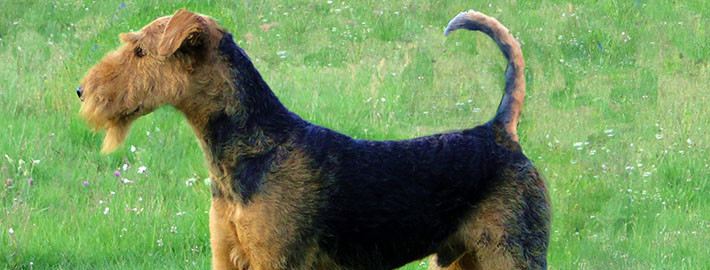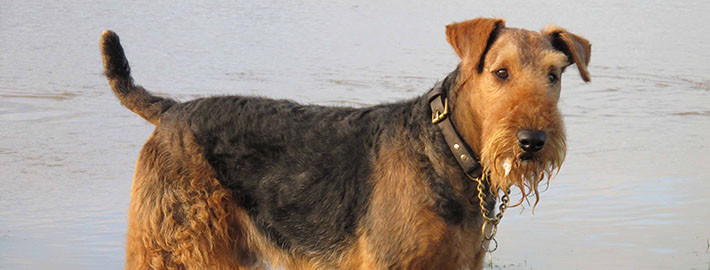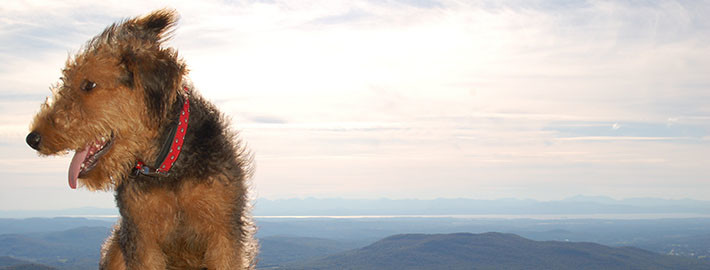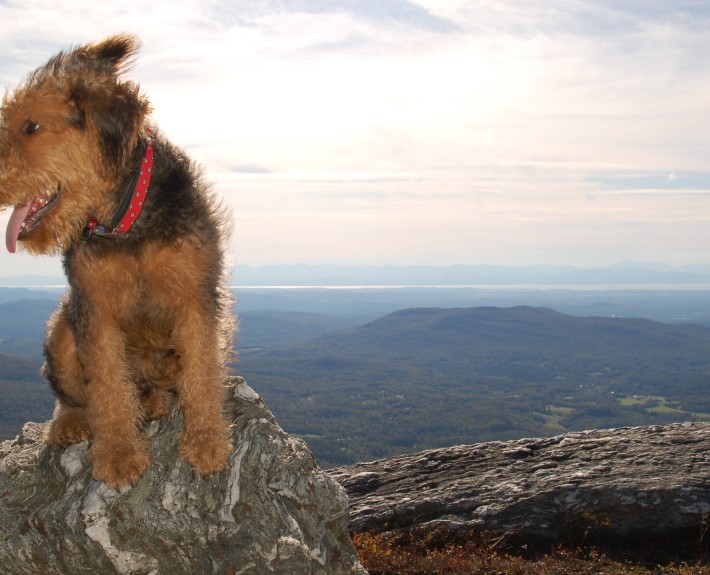What makes the Airedale Terrier Unique?
Airedales are very devoted companions, but they fully expect to be an equal partner in your life. They seem to have a sense of humor about themselves and you, so you had better develop the ability to see humor in all situations. Like when they steal your keys just as you are about to leave for work and run around the back yard with them daring you to try and catch them. Airedales do not respond well to being excluded from family life. You cannot expect an Airedale to be happy and well adjusted if he/she is confined to the backyard or to a single room in the house.
Breed Groups
Page Contents
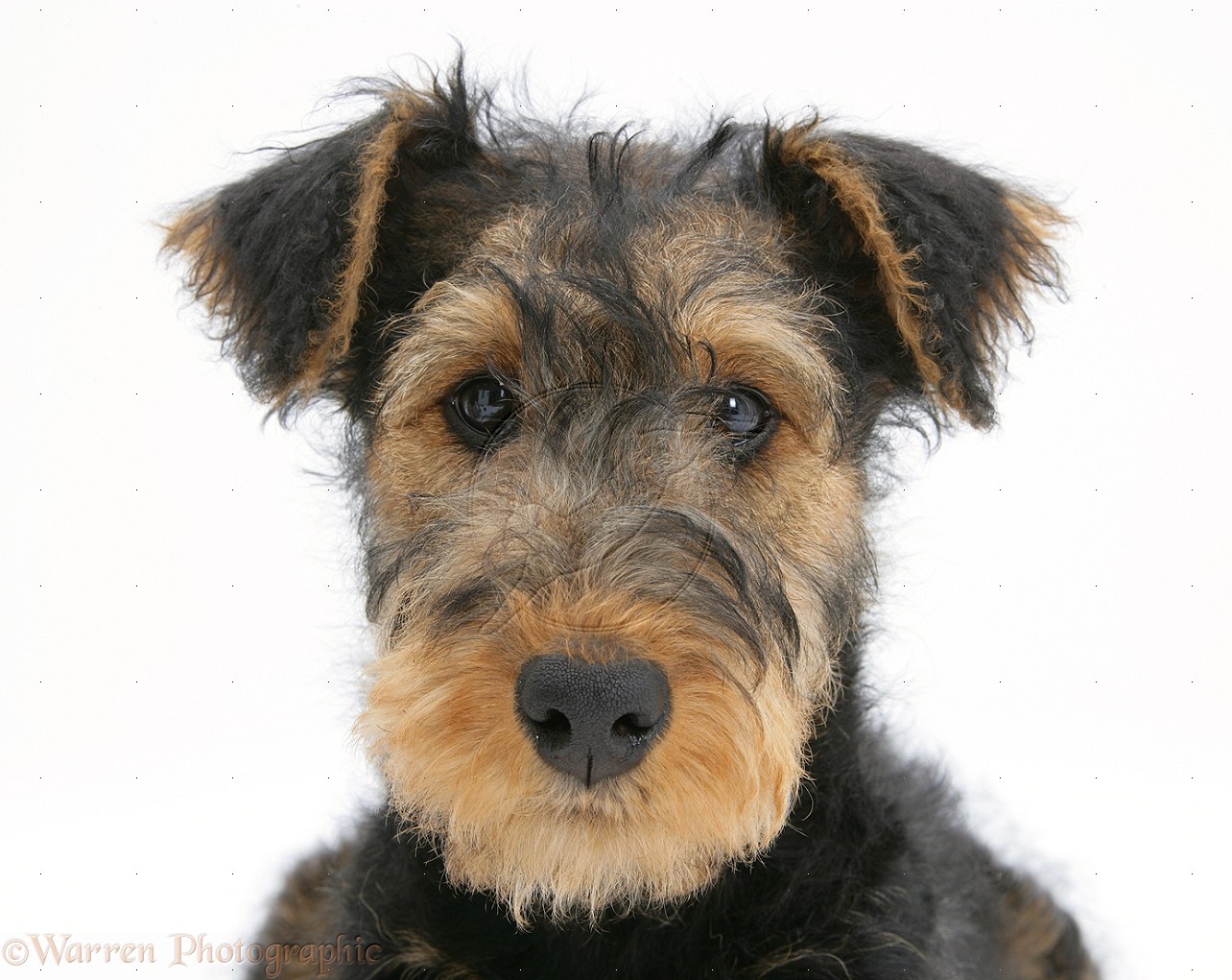
SnapShot
| Size: | Males – 58 to 61 cm (22 to 24 inches) Females – 56 to 59 cm (22 to 23 inches) |
| Weight: | Males – 18 to 20 kg (50 to 65 pounds) Females – 23 to 29 kg (40 to 45 pounds) |
| Origin: | United Kingdom |
| Life Span: | 10 -12 years |
| Colour: | Black saddle with tan ears, legs, and head; dark grizzle saddle (black mixed with gray and white) |
| Litter Size: | 9 puppies |
Is the Airedale Terrier Right For You?
Airedale Terriers can’t learn tricks fast enough. In fact, this dog breed loves to learn new things. You will definitely need a lot of thinking toys for a young Airedale to stay sufficiently busy during the day. A bored Airedale may get into trouble trying to find something to do which may come in the form of destructive behavior like digging holes or climbing fences. The Airedale Terrier is a well rounded family dog. With a reserved bark response to danger these dogs make great watch dogs for the home. If you enjoy outdoor activities like hiking, hunting and fishing the Airedale will be a good fit in your active family.
In 5 Words
- Hard-working
- Hard-playing
- Vigilant
- Protective
- Loves attention
Characteristics
Learn About the Airedale Terrier
Description
Size
Male Airedale Terriers weigh approximately 50 to 65 lbs. and measure up to 24 inches (61 cm) in height, while females weigh 40 to 55 lbs. and are 22 to 23 inches (56 to 59 cm) tall.
Coat
The Airedale’s coat consists of a wavy topcoat, which is thick and has a rough, wire-like texture, as well as an under layer that is short and smooth. It is often said to give the dog a “shaggy” appearance that makes the breed unique and easily distinguishable. The coat is typically black and tan with occasional specks of white, and a grizzle saddle; meaning that there is usually a black or blue-gray section in the coat that goes along the back in the same manner that a horse saddle would go on a horse. Too much white, a soft coat texture, and curls are all considered undesirable physical traits in the breed.
- Head: Well proportioned, without wrinkles. Long, flat skull. Stop hardly visible. Flat cheeks. Powerful jaws. Tight lips.
- Ears: Small, v-shaped, carried to the side of the head. Topline of folded ear should be slightly above level of the skull.
- Eyes: Small, dark color. Very lively expression.
- Body: Must not be too long. Muscular neck without dewlap. Chest well let down. Ribs well sprung. Muscular loin. Short, strong, straight back.
- Tail: Set high, carried gaily, but not curled over the back. Typically docked.
- Hair: Hard, dense, wiry, not so long as to appear shaggy. Hair is straight, dense, and lies close to the skin. Undercoat is shorter and softer.
- Coat: Saddle and top of the neck and tail are black or grizzle. All other areas are tan. Ears are often darker tan and a black mixture is often found around the neck and sides of the head. Some white hairs on the front feet are permissible.
- Size: Dog: approx. 58 to 61 cm (23-24 in).Bitch: approx. 56 to 59 cm 22-23 in).
- Weight: Approx. 20 kg (44 lb).
Short History of the Akita
Airedale Terriers are known as the biggest of the terrier breeds, and were developed in Yorkshire, England specifically to hunt on land as well as off land for sport such as otter and rat. In 1853, a Rough-Coated Black and Tan Terrier was crossbred with an Otterhound, which resulted in an excellent hunting dog known as the Waterside or Bingley Terrier. In 1864, the newly found dog breed competed at Aire Valley’s first dog show under the Broken-Haired Terrier category. It wasn’t until 1879 that they became known as Waterside or Bingley Terriers. There was also great debate as to whether the breed originated from Bingley or Aire Valley. However, in 1886, a decision was finally made by England’s Kennel Club to make the breed’s name Airedale Terrier official.
The breed continued to steadily rise in popularity at the beginning of the 20th Century, leading to the formation of the Airedale Terrier Club of America. After WWI took place, the dogs became renowned for their role in the war as messengers, hunters, and carriers (food, medical supplies, etc.). The dogs were so popular at the time, that even important figures such as President Roosevelt and President Coolidge owned and admired this breed of dog. By 1949, they were the 20th most popular dog breed in the U.S., according to the American Kennel Club. Unfortunately, their popularity has only decreased since then, partly due to the rise of the German Shepherd. This is because German Shepherds currently carry out tasks that Airedale Terriers used to do such as search and rescue or police work.
Temperament
Airedale Terriers have an inquisitive, playful, and willful personality. They also make great guard dogs thanks to their protective nature, especially when it involves their friends and family. However, they have a big heart and can even develop a “goofy” side to their personality, as long as they are well-trained and are taught when being protective is appropriate. Overall, these dogs have a good temperament and are extremely loyal, but it is important that owners are prepared to raise an intelligent and active dog. Otherwise, boredom may develop, making it difficult to train or even control this breed of dog.
Caring for Your Airedale Terrier
General Health
Airedales are generally healthy dogs, but like with all breeds, they too are susceptible to various genetic disorders. Some of the most prevalent health issues seen in the breed include; hip dysplasia, hypothyroidism, von Willebrand disease, progressive retinal atrophy, allergies, cataracts, cancer, bloat, elbow dysplasia, epilepsy, hypoadrenocorticism, hyperadrenocorticism, and heart disease. Before selecting a breeder, it is important that owners ask for proof of the parent’s health certificates from the OFA and CERF in order to minimize the risks of getting a puppy with hereditary orthopedic or eye problems. Verifying health records to make sure that the puppies as well as the parents are up to date on exams, vaccines, deworming, etc. is also important.
Grooming & Bathing
Airedale Terriers shed moderately a few times per year. During this period, it’s important to brush the coat regularly (at least once a week) and bathe as needed to reduce the amount of loose hair in the home and environment. Owners should be careful not to bathe the dog too often or use harsh shampoo, as this may make the coat soft and change its natural texture. When it comes to trimming, these dogs are fairly low-maintenance. This is optional in the breed, and most owners only do it to give the coat a clean, structured appearance. To keep up the look, it’s recommended that owners have their dog trimmed about once every three months. Additional grooming tasks that should be done on a regular basis include; brushing the teeth, trimming the nails, and cleaning the ears/eyes. While the dog is being groomed, it is also very important that the whole body is inspected for anything unusual such as; wounds, debris, irritation, foul ear odor, etc. This can help catch problems early on and allow for the best care, or if needed, treatment.
Exercise & Training
Airedales are naturally energetic due to their original role as a working dog. They do best in environments with large yards where they can run around and play, as well as with owners that can provide them with plenty of exercise throughout the day. Going walking or jogging at least once daily is recommended in order for this breed to be content and keep its energy levels balanced. Failure to provide these dogs with sufficient exercise usually leads to boredom and unwanted behavior. Fun activities such as playing fetch and going swimming can be helpful in preventing this from happening.
Socialization is a very important part of training an Airedale Terrier because they can be overprotective and wary of strangers. During the socialization process, the dogs need to be exposed to a variety of settings, situations, animals, and people. Some examples include; taking the dog to a pet store, park, lake, city setting, country setting, camping, and more. Of course, obedience training is also crucial, and it is the key to developing a well-rounded and well-behaved Airedale. The training method of choice for any dog is positive reinforcement, but with this breed, owners must be careful not to be overly repetitive or this will lead to boredom and loss of focus. Short games and breaks in between training sessions are highly recommended.
Health care for a Airedale will include proper affection, nutrition, exercise, sanitized living environment, veterinary care, immunization against canine diseases, grooming, and ongoing protection against parasites.
When selecting your dog food, important phrases like, “complete and balanced” and “meet or exceeds the nutritional levels established by the National Research Council” should appear on the label. Other considerations might include:
- digestibility-lamb and rice can be an excellent choice…
- protein sources-muscle meat, organic meat, eggs, milk…
- protein levels-should not exceed 24% adult food at 4-5 months of age…
- vegetable sources-soybean, corn, and other grains…
- preservatives-naturally preserved w/vitamin E is a favorite…
Be careful not to supplement unbalanced foods and try not to exceed ten percent by weight of the regular diet. Balanced supplements include:
- cottage cheese
- cooked eggs
- milk

